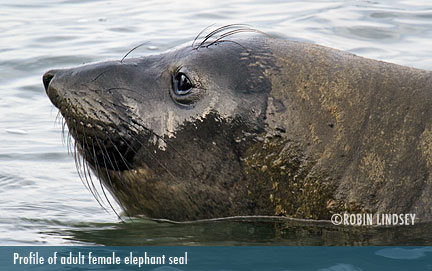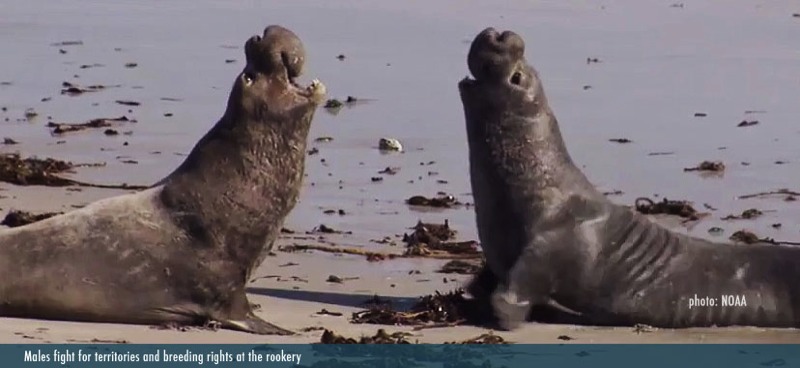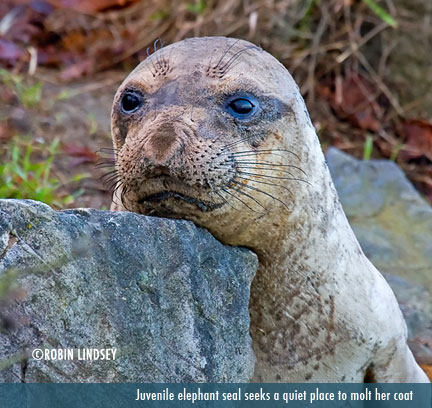ABOUT ELEPHANT SEALS
 PHYSICAL DESCRIPTION Elephant seals have coats that vary in color, from silver-gray to brown or black and are typically covered with many fine to medium spots. The mottled coats provide excellent camouflage on pebbled beaches. Reaching five to six feet in length and weighing up to 300 pounds, males are slightly larger than females. Called “true" seals or "common" seals, they have no external ear flaps, small flippers and move on land by bouncing along on their bellies. They have a small tail between their rear flippers.
PHYSICAL DESCRIPTION Elephant seals have coats that vary in color, from silver-gray to brown or black and are typically covered with many fine to medium spots. The mottled coats provide excellent camouflage on pebbled beaches. Reaching five to six feet in length and weighing up to 300 pounds, males are slightly larger than females. Called “true" seals or "common" seals, they have no external ear flaps, small flippers and move on land by bouncing along on their bellies. They have a small tail between their rear flippers.
RANGE AND HABITAT Harbor seals are found in both the Atlantic and Pacific north of the equator. In the Northern Pacific they range from Alaska to Baja, Mexico. They inhabit shallow waters close to shore and favor sandbars and beaches and haul out at low tide to rest and warm up.
MATING AND BREEDING Most male and female harbor seals become sexually active at ages three to six or seven years. Adult females usually mate and give birth to one pup every year; the size of a pup can be 1/4 to 1/3 that of the mother. The gestation period is 9-11 months. Females will give birth on shore, on ice floes and in the water.
Mating resumes shortly after the female has given birth and delayed implantation appears to ensure that pups are born in the proper season with a higher survival rate. Harbor seal males are somewhat more monogamous than some pinnipeds, mating with one to several females per year. Harbor seals usually return to the same breeding grounds every year.

RANGE AND HABITAT Harbor seals are found in both the Atlantic and Pacific north of the equator. In the Northern Pacific they range from Alaska to Baja, Mexico. They inhabit shallow waters close to shore and favor sandbars and beaches and haul out at low tide to rest and warm up.
MATING AND BREEDING Most male and female harbor seals become sexually active at ages three to six or seven years. Adult females usually mate and give birth to one pup every year; the size of a pup can be 1/4 to 1/3 that of the mother. The gestation period is 9-11 months. Females will give birth on shore, on ice floes and in the water.
Mating resumes shortly after the female has given birth and delayed implantation appears to ensure that pups are born in the proper season with a higher survival rate. Harbor seal males are somewhat more monogamous than some pinnipeds, mating with one to several females per year. Harbor seals usually return to the same breeding grounds every year.

SENSES Harbor seals have a highly developed sense of hearing. Their hearing is almost 14x more acute underwater than on land. Their sense of hearing is important for their protection against predators and they have learned to distinguish between potentially lethal transitory killer whales and harmless resident ones in the Pacific Northwest. Harbor seals’ large, dark eyes are well adapted for underwater vision, but they have poor eyesight on land and appear not to see in color. Their eyes are covered with a protective mucus which coats the eyes underwater and often appears as a wet ring around them when they are onshore.
Harbor seals can detect prey by using nerves in their whiskers (“vibrissae”) that sense a change in pressure or vibrations in the water. Harbor seals use their acute sense of smell to find a lost pup. Unlike sea lions, harbor seals rarely vocalize on land except during pupping season or when threatened. They often communicate by slapping the water with their flippers. Underwater, however, seals communicate using a series of eerie sounds. View documentary video of waddell seals underwater in Antarctica.
 BEHAVIOR Harbor seals are unusual in that they spend about half their time on land and half in water, and they are able to sleep in the water. Although they are able to dive to depths of 650 feet and stay submerged for over 20 minutes, they typically dive to a much shallower depth where their food is located. Their diet consists of many varieties of fish as well as octopus and squid. Harbor seals are usually solitary animals except during breeding season or when hauled out. Once weaned, pups form bonds with other young seals for protection and no longer accompany their mothers. View video of a seal's watery world.
BEHAVIOR Harbor seals are unusual in that they spend about half their time on land and half in water, and they are able to sleep in the water. Although they are able to dive to depths of 650 feet and stay submerged for over 20 minutes, they typically dive to a much shallower depth where their food is located. Their diet consists of many varieties of fish as well as octopus and squid. Harbor seals are usually solitary animals except during breeding season or when hauled out. Once weaned, pups form bonds with other young seals for protection and no longer accompany their mothers. View video of a seal's watery world.
NATURAL PREDATORS The harbor seal’s main predators are orcas, sharks and polar bears. Coyotes, bears, eagles, stellar sea lions and walruses often prey on unprotected or sickly pups.
HUMAN IMPACT Once widely hunted for their luxurious coat and rich blubber (government sanctioned hunting of seals still takes place in some regions such as Scotland, Canada, Norway and Iceland), modern man creates additional risks to all species of seals and their pups. Seals often drown by entanglement in commercial fishing nets, gillnets in particular. Seals also suffer serious wounds from nets, fishing line and barbs that can lead to infections and death. Additionally, they are often intentionally killed by fishermen who erroneously believe they are responsible for reduced fish stocks caused by overfishing, habitat destruction and pollution. However, more knowledgeable fishermen no longer blame seals and sea lions and appreciate them for being an integral part of a complex ecosystem.
Environmental pollution has created an extreme risk for harbor seals and other marine mammals. Polluted waters lead to low body weight, infections and increased susceptibility to viruses and parasites, often resulting in death.
Harbor seals can detect prey by using nerves in their whiskers (“vibrissae”) that sense a change in pressure or vibrations in the water. Harbor seals use their acute sense of smell to find a lost pup. Unlike sea lions, harbor seals rarely vocalize on land except during pupping season or when threatened. They often communicate by slapping the water with their flippers. Underwater, however, seals communicate using a series of eerie sounds. View documentary video of waddell seals underwater in Antarctica.

NATURAL PREDATORS The harbor seal’s main predators are orcas, sharks and polar bears. Coyotes, bears, eagles, stellar sea lions and walruses often prey on unprotected or sickly pups.
HUMAN IMPACT Once widely hunted for their luxurious coat and rich blubber (government sanctioned hunting of seals still takes place in some regions such as Scotland, Canada, Norway and Iceland), modern man creates additional risks to all species of seals and their pups. Seals often drown by entanglement in commercial fishing nets, gillnets in particular. Seals also suffer serious wounds from nets, fishing line and barbs that can lead to infections and death. Additionally, they are often intentionally killed by fishermen who erroneously believe they are responsible for reduced fish stocks caused by overfishing, habitat destruction and pollution. However, more knowledgeable fishermen no longer blame seals and sea lions and appreciate them for being an integral part of a complex ecosystem.
Environmental pollution has created an extreme risk for harbor seals and other marine mammals. Polluted waters lead to low body weight, infections and increased susceptibility to viruses and parasites, often resulting in death.